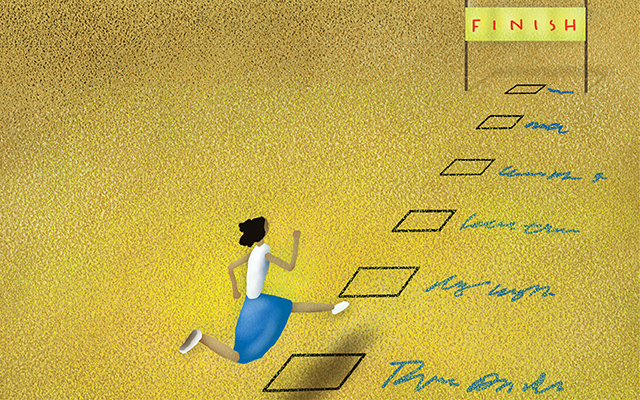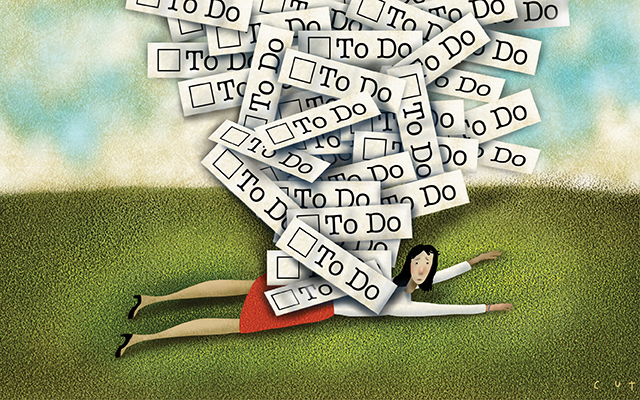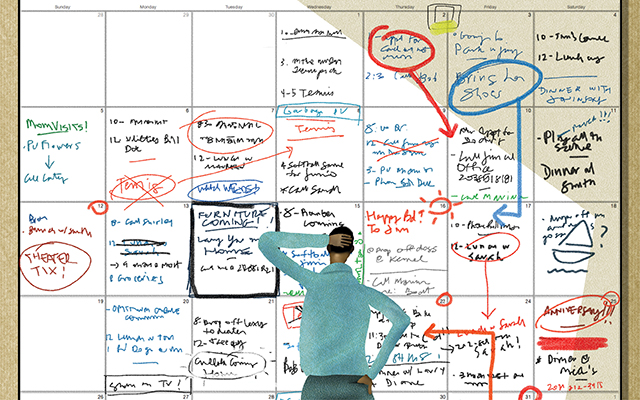When big goals fail to take shape, there’s usually a simple explanation, says David Allen, productivity guru and author of Getting Things Done (Penguin, 2002) and Making It All Work: Winning at the Game of Work and the Business of Life (Viking, 2008). If we’re not making progress, he says, it’s usually because we’re uncertain about what action to take next.
Every destination is reached by way of a series of small steps. Your necessary next action might be small or easy, like making a phone call or looking up information online, but it can stand between you and getting something done if you can’t identify what it is — or when to tackle it. When we’re unclear about our next action, we typically don’t do anything. And this leaves projects vulnerable to stagnation.
In the previous parts of this series, Allen taught us how to collect the stuff related to our goals — from physical objects to floating ideas. He provided strategies to process their meaning and organize them so it’s easier to get projects done. He also suggested making time to review priorities, lists, inboxes and action plans to keep them updated and effective. In the fifth and final stage of his system, the do stage, he teaches how to identify which “next action” is necessary to reach your goals.
This concept, says Allen, is nothing short of transformative. “I have generated more creative thinking, tough decision-making, critical conversations, innovative ideas, clarity and motivation [with next actions] than by using any other specific technique,” he says, because it breaks our big projects down into manageable tasks — which gets them done.
Next-Action Magic
Virtually all project lists need some processing in order to translate vague ideas into actionable tasks. “The fundamental engagement question is ‘What’s the next action?’” Allen says. “The answer creates the bridge from the invisible to the visible, from idea into reality.”
Let’s say your heart’s desire is a clean, well-organized closet, but you’re still tripping over the same mismatched shoes every morning. Allen would suggest breaking this project down into discrete tasks. Otherwise, he explains, your eyes will likely glaze over when you see “clean out closet” on your project list. It’s just too big of a process to dig into on any given day.
Initially, the next action for this project might simply be “schedule time,” or “ask friend to help.” After that, next actions might be “obtain boxes for sorting,” “empty shelves,” “sort clothes into keep and giveaway piles,” “measure wall for new shelves,” “take bags to Goodwill,” and so on.
In some cases, identifying next actions can take longer than actually completing them. But in the absence of that thought process, things are unlikely to happen at all. That’s why Allen recommends spending a little time each morning processing items on your calendar and to-do list to clarify (and perhaps schedule) the next actions that make sense with your current commitments.
“Thinking demands time,” says Allen, “and thinking is required for defining and managing your work.” Once you’ve defined your next move, though, acting becomes easy. You’re moving toward your goal without having to think about it at all.
Define To-Dos in Concrete Terms
To-do lists often fail to contain the next actions necessary for progress. For example, if you keep breezing past “contact Bill” on your list, it may be because you don’t have Bill’s contact information, or because you’re waiting for an email introduction from someone else, or because you haven’t decided whether to call, email or drop him a note.
Until you’ve clarified that next action, and something like “find Bill’s contact info” or “email Sally and remind her to make Bill intro” appears on your to-do list, Bill will likely remain uncontacted.
Allen notes that undetermined next actions can sap energy as well as obstruct progress. Every incomplete decision floating around your head acts as a little snag on mental energy. “In order to silence that monkey in your mind, you must complete the thinking process,” he says.
Taking a few moments to determine your next action frees up mental space and energy. In this case, assuming you have his number, you might simply decide you will call Bill rather than email him. Done. You can stop thinking about it until you pick up the phone.
There will be cases where a “next action” persists in remaining unclear, especially when processing more complex tasks. If your project involves finding a new job, at some point your next action will be “revise résumé.” This might stop you cold. Where to start? In these cases Allen recommends three follow-up questions:
- What has to happen first? Locate old résumé.
- What does “doing” look like? Sorting through files in a drawer.
- Where does it happen? The file cabinet in the back room.
It may seem daunting that a single to-do item encompasses dozens of small tasks. But when goals are broken down into achievable actions, rather than projects of indeterminate scope, you become empowered instead of intimidated.
Tracking Tasks
Allen recommends storing a total-life checklist, or “action reminder system,” separate from and in addition to your project lists. His books describe the system he recommends for this purpose, and emphasize that you can use whatever paper-based or electronic tools work best for you. (You may want to consider a multiplatform application like OmniFocus if you choose an electronic system.)
This master checklist allows you to access possible next actions quickly and make progress on multiple projects throughout the day. Your “total-life action reminder” will contain a smorgasbord of possible next actions, so how do you choose what to do first? Allen suggests asking the following:
What can I do? Three-quarters of the things on your life list probably can’t be done where you are right now, Allen says. If you want to cross “write last section of 2013 budget” off your list, and the project file with the numbers is at the office and you’re not, you’ll have to wait until you have the file in hand again. Identify what can be accomplished where you are now, with the reference material and equipment you have on hand.
How much time do I have? If you’re picking up the kids in 10 minutes, you can’t do a 20-minute task. Of all your available to-dos, something quick (like “make dinner reservation”) is the item that will make the most of your time.
How much energy do I have? Consider both the physical and mental energy you have available. Whenever possible, save big-ticket actions for days and times when you’re feeling fresh, and do more mindless tasks when you’re winding down.
The goal of Allen’s overall approach is straightforward: to allow you to “define what ‘done’ means, and what ‘doing’ looks like.” Getting things done is easier when you get stuff out of your head and the back corners of your file drawers (collect), figure out what it all means (process), park these items where they’re most usable and useful (organize), consistently check in with your systems to keep them up to date (review), and use those systems to help you establish what you need to do next to get projects done (do).
Once you’ve adopted some version of this method that works for you, you won’t just get more things done — you’ll get them done with a more peaceful mind. Then you can enjoy the journey.




This Post Has 0 Comments